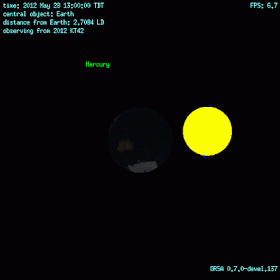Cbet nr. 3127, issued on 2012, May 28, announces the discovery of a new comet (discovery magnitude 18.5) by the LINEAR survey on CCD images taken with the 1.0-m f/2.15 reflector on May 25.3. The new comet has been designated C/2012 K5 (LINEAR).
We performed some follow-up measurements of this object, while it was still on the neocp. Stacking of 8 R-filtered exposures, 120-sec each, obtained remotely, from the ITelescope network (near Mayhill, NM) on 2012, May 27.4, with a 0.43-m f/6.8 astrograph + CCD,shows that this object is a comet coma 10" in diameter and a tail nearly 20" long in PA 210 deg.
We performed some follow-up measurements of this object, while it was still on the neocp. Stacking of 8 R-filtered exposures, 120-sec each, obtained remotely, from the ITelescope network (near Mayhill, NM) on 2012, May 27.4, with a 0.43-m f/6.8 astrograph + CCD,shows that this object is a comet coma 10" in diameter and a tail nearly 20" long in PA 210 deg.
Our confirmation image (click on the image for a bigger version):
M.P.E.C. 2012-K69 assigns the following preliminary parabolic orbital elements to comet C/2012 K5: T 2012 Nov. 29.04; e= 1.0; Peri. = 138.80; q = 1.15 AU; Incl.= 92.84
by Ernesto Guido, Giovanni Sostero & Nick Howes
by Ernesto Guido, Giovanni Sostero & Nick Howes

















